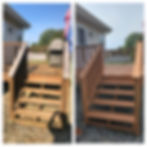Is a Second Coat Worth It When Deck Staining?
- ajpfaff2
- Feb 20, 2024
- 3 min read
Staining a deck is a crucial step in its maintenance, providing both a beautiful appearance and protection against the elements. While applying a single coat of stain may seem sufficient at first, opting for a second coat can significantly enhance the durability and appearance of your deck. In this article, we'll delve into why applying a second coat is worth it when deck staining and consider factors such as the type of stain, application process, and long-term benefits.

Oil-Based vs. Water-Based Stain:
Before delving into the benefits of a second coat, it's essential to understand the difference between oil-based and water-based stains. Oil-based stains penetrate deep into the wood, providing excellent protection against moisture and UV damage. They tend to offer a rich color, a shiny finish, and longer-lasting results. On the other hand, water-based stains are eco-friendly, dry faster, and emit fewer fumes during application. While both types of stains can benefit from a second coat, the application process does vary.
In general, oil-based stains will need more attention on the second coat application. Read the manufacturer's instructions on the stain can for exact instructions. Water-based stains are usually very easy to apply a second coat to as long as the first coat is clean and dry. For more info on water-based vs oil-based stains, read our article on What Type of Deck Stain is Best?
Enhanced Protection and Longevity:
One of the primary reasons for applying a second coat of stain is to enhance the deck's protection and longevity. A second coat provides an additional layer of defense against moisture, UV rays, and general wear and tear. This extra barrier helps prevent cracking, warping, and fading, ultimately extending the lifespan of your deck. Especially in regions with harsh climates or frequent high UV index readings, a second coat can make a significant difference in preserving the wood's integrity over time.

Improved Quality of Finish:
In addition to prolonging the deck's lifespan, a second coat of stain can enhance the overall quality of the finish. While a single coat may provide adequate coverage, a second coat ensures more uniform coloration and saturation, resulting in a richer, more vibrant appearance. It helps to even out any inconsistencies or imperfections in the first coat, leaving behind a smooth, professional-looking finish. This attention to detail not only enhances the deck's visual appeal but also adds value to your property.
Application Process and Time Investment:
Applying a second coat of stain is relatively straightforward, especially if you've already completed the first coat. Depending on the type of stain used and the condition of the deck, the second coat can be applied shortly after the first coat has dried. While the exact drying time may vary, it typically ranges from an hour to a day, depending on factors such as temperature, humidity, and ventilation.
Compared to the initial application, applying a second coat will require less time and effort, as you're already familiar with the process, have addressed any preparation steps beforehand, and have a smoother surface to work on. With proper planning and organization, adding a second coat can be a seamless and efficient task, offering long-term benefits with minimal additional investment. At EcoWash, we always discount a second coat by 45% when compared to the first coat due to the ease of application.

FAQs:
Q: Can I apply a second coat of stain immediately after the first coat?
A: It's essential to allow the first coat of stain to dry completely before applying a second coat. Depending on the type of stain and weather conditions, this may take anywhere from an hour to a day. Applying a second coat too soon can result in uneven coverage and poor adhesion.
Q: Is it necessary to sand the deck between coats of stain?
A: In nearly all cases, sanding between coats of stain is not necessary or recommended. However, if you notice any rough patches or imperfections after the first coat has dried, lightly sanding the surface can help achieve a smoother finish before applying the second coat. It is important to note that a smoother finish may not be noticeable on a deck and will not retain its smoothness with exposure to the elements.
Q: How often should I reapply stain to my deck?
A: The frequency of restaining your deck depends on various factors, including the type of stain used, the climate, and the amount of foot traffic it receives. In general, it's recommended to restain your deck every 2-5 years to maintain its appearance and protection. Regular inspection and maintenance can help identify when it's time for reapplication.
If you are a homeowner in the Midwest looking for a high-quality deck staining contractor for your deck staining project, reach out to EcoWash today.
